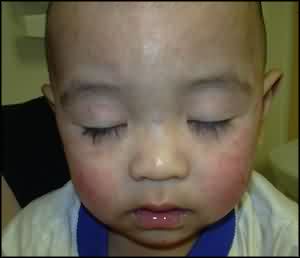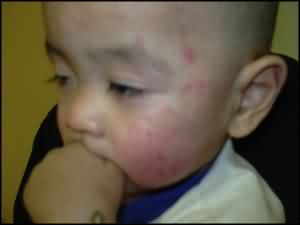What is eczema?
Eczema is a common skin condition seen in general practice particularly among infants. It is also known as atopic dermatitis.
The affected skin is dry and inflamed with the presence of swelling, itchiness, red papules (small raised rashes) and oozing. It is a chronic (long term) condition that causes itchiness.
Eczema is most frequently found on the face, wrists and inner surfaces of the elbows and knees. The affected skin may become thickened.
Usually children get eczema before the age of 5 years. Unfortunately there is no cure for eczema. However, there are many ways to keep eczema under control. It is not an infection, and is not contagious.
What causes eczema?
- It is a hereditary condition.
- It is an atopic condition (sensitive to allergens), and is associated with other atopic conditions like asthma and allergic rhinitis.
- It is not an allergy itself, but allergies can trigger eczema.
- It can be triggered by many things including:
- becoming overheated with wool clothing and blanket
- skin dryness
- irritation from soaps, detergents, or perfumes
- food allergies or intolerances
- viruses and other common infections
What are the symptoms & signs of eczema?
- Babies with eczema usually have a red, dry rash on their face. The rash may be on their scalp, body, arms and legs or behind their ears.
- In toddlers and older children, the eczema rash is often in the skin creases around the knees, wrists, elbows and ankles.
- In some children the rash can cover their entire body.
- Secondary bacterial or viral infections can occur when eczema is not well controlled. Signs of secondary infection are weepy, crusted and broken areas of eczema.
Some examples of eczema:
 |
 |
How can eczema be treated medically?
Consult your doctor to confirm the diagnosis. He will prescribe some or all of these :
- Antihistamine for itchiness.
- Moisturizing lotion, cream or ointment to control the dryness and itchiness.
- Steroid creams for severe cases.
- Antibiotic if secondary bacterial infection is present.
The above treatment only helps to control the symptoms not to cure it. Eczema can reappear when exposed to allergens.
How else can I help my child?
Identify and avoid triggers:
- Soaps and Cleansers
Usage of soaps, antiseptic wash and bubble baths should be avoided. They remove the natural oils from the skin, making the skin dry, itchy and more prone to irritation. Instead use a soap substitute plus a bath/shower emollient, such as aqueous cream.
- Biological washing powder and fabric conditioners
These can also worsen eczema. Patients are advised to wear rubber gloves with cotton lining when using detergents or working with other similar chemicals. After washing clothes with detergent, rinse them well.
- Toiletries and perfumes
Many children with eczema find these products irritating to the skin. It may be best to avoid these or only use bland products.
- Clothing, bedding and car seat covers
Use cotton materials rather than wool or prickly materials that may irritate the skin.
- Temperature
Extremes of temperature and humidity may trigger a flare-up of eczema. Limit bath duration to 10 minutes and use luke-warm/ cool water to reduce flare-ups tendencies. Dress your child in one or two thin layers of cotton clothing.
- Dummies, dribbling or food around the mouth
Apply thick moisturiser around the mouth, wash the skin with a soft, wet towel after eating and then reapply the moisturiser.
- Environmental allergens
Pet fur, pollen and house dust mites are some examples of allergens which can irritate the skin and cause flare-ups of eczema. If you think your child may be allergic to one of these allergens, best to avoid the allergen and see if things improve.
Avoid carpets and soft furnishing in the bedroom, and keep soft toys to a minimum. Wet-dust the bedroom furniture every 1-2 weeks. Vacuum or clean the bedroom floor and mattress regularly. Use a vacuum cleaner with a good filter (this removes the mite and prevents small particles coming out through the vacuum exhaust). Regularly ventilate the bedroom (open the door and a window for a while on most days).
- Stress, habitual scratching and the itch-scratch cycle
Stress has been identified as a possible trigger. Some people react to stress by habit scratching. It is thought that scratching can release more chemicals, which worsen the itch. This is called the itch-scratch cycle.
To help this, keep your child’s fingernails short and clean.. Consider mittens for babies and cotton gloves at night if your child tends to scratch at night. Relaxation exercises or similar techniques help to reduce stress. This may help to reduce habit scratching, which may help to reduce severity of eczema.
- Infection
Localized skin infection is usually introduced by scratching and it can aggravate eczema. Common cold and some other bacterial infections can also trigger eczema.
- Food allergy and eczema
Younger children with severe eczema may have food allergy as a triggering factor. The most common foods which trigger eczema include cows’ milk, eggs, soya, wheat, fish and nuts. If food allergy is suspected, do consult a doctor. Leaving out certain foods without an allergy being confirmed is not usually recommended.
- Other possible triggers
- Mold
- Dust and sand
- Chlorine
- Solvents
- Irritant in the environment
- Cigarette smoke
- Actions and environments that cause the skin to dry out:
- prolonged exposure to water
- being too hot or too cold
- sweating and then becoming chilled
- taking baths or showers that are too hot or last too long
- not using a skin lubricant after a bath
- low humidity in the winter
- living in a climate that is dry year-round
Keep the skin moisturised:
- A thick, plain moisturiser with no fragrance should be used as often as necessary on your child, even when the skin is clear of eczema. Some children will require moisturiser application once or twice a day, while others will need it more often. Thicker creams are more effective than lotions.
Key points to remember
- There is no cure for eczema but it can be well controlled.
- Severity of the eczema can change commonly, and it is important to control the eczema as soon as it flares up.
- To control eczema, keep your child cool, moisturise them frequently, and keep them away from things that irritate their skin.
- For eczema that’s difficult to manage, consult your doctor for an eczema treatment plan.
References:
- http://www.webmd.com/skin-problems-and-treatments/eczema/eczema-causes
- http://kidshealth.org/parent/infections/skin/eczema_atopic_dermatitis.html
- http://www.patient.co.uk/health/Eczema-Triggers-and-Irritants.htm
- https://www.rch.org.au/kidsinfo/fact_sheets/eczema/
|
Last reviewed |
: |
10 May 2024 |
|
Content Writer |
: |
Dr. Thenmoli a/p Palaniyappan |
|
Reviewer |
: |
Dr. Zahrni bt. Muda |







